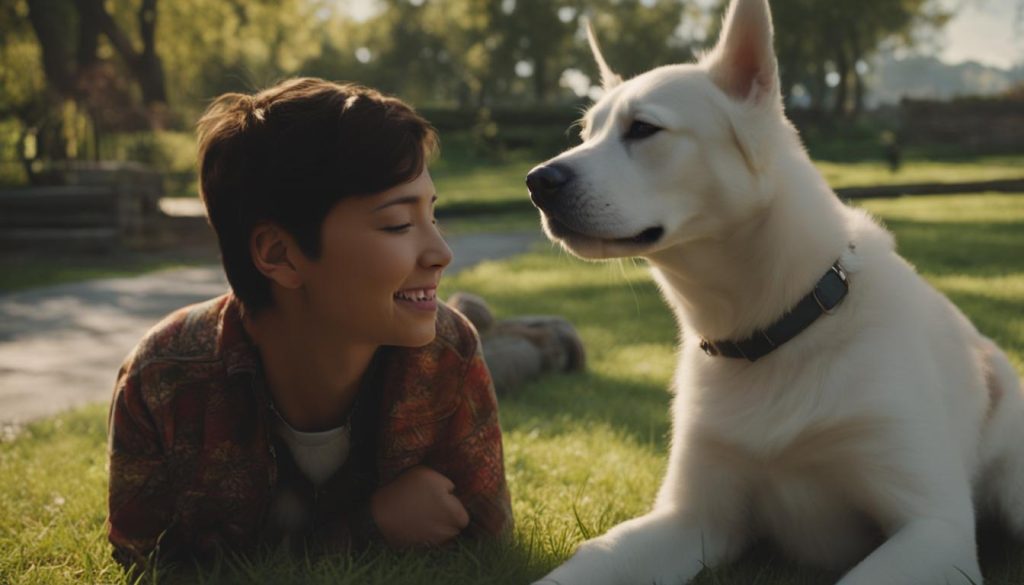Have you ever wondered why your dog winks at you? This peculiar behavior might leave you puzzled, but fear not, as I’m here to decode your furry friend’s actions. Dogs communicate in various ways, and winking is just one of their many behaviors that hold hidden meanings.
There can be multiple reasons why your dog winks at you. It could be an attempt to mimic your behavior, a way of seeking attention, or a form of communication to express their desires. However, excessive winking or blinking could indicate underlying health issues, which should be evaluated by a veterinarian.
Key Takeaways:
- Dogs may wink to mimic their owner’s behavior, seek attention, or communicate their desires.
- Understanding a dog’s eye gestures and body language is crucial in deciphering the meaning behind their winks.
- Dogs have unique eye anatomy and can develop various eye problems, so it’s important to pay attention to their eye health.
- Winking can indicate affection, avoidance of conflict, or a desire for something.
- Excessive winking could be a sign of underlying health issues, and veterinary care should be sought if necessary.
Understanding Dog Winks

When it comes to dog behavior, winking is a fascinating gesture that can convey a variety of messages. To properly interpret a dog’s wink, it is important to understand their body language and eye communication. Dogs may wink as a form of communication, showing affection, or avoiding conflict. By observing their eye gestures and overall body language, we can gain insights into the meaning behind their winks.
Winking can be a sign that a dog is at ease and seeking attention. It can indicate that they are mimicking their owner’s behavior or trying to communicate a desire for something. Understanding a dog’s eye gestures can help us decipher their intentions. For example, a slow, deliberate wink accompanied by relaxed body language may indicate trust and contentment, while a rapid or repeated wink could signal excitement or playfulness.
The Role of Canine Body Language
Canine body language plays a significant role in understanding dog winks. In addition to the wink itself, we need to pay attention to other cues such as tail position, ear position, and overall posture. A dog with a relaxed, wagging tail and loose body movements is likely using the wink as a friendly gesture, seeking attention or showing affection. On the other hand, a dog with a tense body, raised hackles, or a stiff tail may be using the wink as a way to avoid conflict or assert dominance.
| Wink Behavior | Meaning |
|---|---|
| Slow, deliberate wink | Trust, contentment |
| Rapid or repeated wink | Excitement, playfulness |
| Wink with relaxed body language | Affection, seeking attention |
| Wink with tense body language | Avoiding conflict, asserting dominance |
By combining our understanding of dog eye communication and body language, we can better decipher the meaning behind a dog’s wink. It is important to remember that each dog is unique, and their winking behavior can vary. Paying close attention to their individual cues and context will help us form a more accurate interpretation.
“Understanding a dog’s wink requires attentiveness to their body language and eye communication. By observing their overall behavior and context, we can gain insights into the meaning behind their winks.”
Dog Eye Basics
Dogs have fascinating eye anatomy that differs from humans. Understanding the basics of dog eyes can help decipher their behavior, including winking and blinking. Here are some key points to know:
- Dogs have a third eyelid called the nictitating membrane, which helps protect and moisturize their eyes.
- Unlike humans, dogs have a wider field of vision, allowing them to see more of their surroundings.
- However, dogs do not see as clearly as humans and have limited color vision.
- Some dog breeds are more prone to eye conditions such as cataracts, glaucoma, and entropion, a condition that can cause excessive winking or blinking.
Dog Eye Contact
Eye contact is an important part of dog communication. When a dog makes direct eye contact with their owner or another dog, it can convey different messages:
- Staring with a relaxed gaze can indicate trust and affection.
- Avoiding eye contact or looking away may be a sign of submission or fear.
- Intense or prolonged eye contact can be a challenge or a sign of aggression.
Understanding the subtle cues of dog eye contact can help interpret their intentions and emotions.
Decoding Dog Winks
Winking is just one of the many ways dogs communicate. While there isn’t a single universal meaning behind a dog’s wink, it can have various interpretations, including:
- Mimicking behavior: Dogs sometimes mimic their owner’s actions, including winking.
- Attention-seeking: Winking can be a way for dogs to catch their owner’s attention or request something.
- Affection: Dogs may also wink as a sign of affection, similar to a human’s wink or a gentle “I love you” gesture.
- Relaxation: In some cases, a dog’s wink can indicate that they are at ease and comfortable in their environment.
Deciphering the meaning behind a dog’s wink requires observation of their overall body language and context.
| Winking Behavior | Possible Meanings |
|---|---|
| Mimicking owner’s wink | Copying behavior |
| Requesting attention | Seeking interaction or play |
| Displaying affection | Expressing love or bonding |
Common Reasons for Dog Winking
Interpreting dog signals can be a fascinating journey into understanding our furry companions. When it comes to dog winking, there are several common reasons why dogs engage in this behavior. By observing their body language and behavior cues, we can gain valuable insights into what their winks may mean.
Signs of Affection
Dogs often use winking as a way to show affection towards their owners. Just like humans might wink to convey a sense of playfulness or intimacy, dogs may do the same. A gentle wink from your furry friend can be a sweet gesture that signifies their love and trust in you. It’s their way of saying, “I’m happy to be with you.”
Avoiding Conflict
Another reason why dogs may wink is to avoid conflict or defuse tense situations. Dogs are highly attuned to the emotions and body language of those around them. If they sense tension or aggression, they may wink as a way to signal their non-threatening intentions. It’s their way of saying, “I mean no harm, let’s keep things calm.”
Imitating Behavior
Dogs are known for mimicking their owners’ actions and behaviors. If you find yourself winking at your dog or using winking as part of your communication style, they may start to imitate this behavior. It’s their way of connecting with you and forming a stronger bond. Winking can become a shared language between you and your furry companion.
While these are some common reasons for dog winking, it’s essential to consider the overall context of the situation. Each dog is unique, and their winks may carry individual meanings based on their personalities and experiences. By paying attention to their body language and behavior cues, you can build a deeper understanding of your dog’s communication style.
Excessive Winking in Dogs

While occasional winking is normal in dogs, excessive winking can be a cause for concern. It is important to pay attention to your dog’s eye health and seek veterinary care if you notice persistent or frequent winking. Excessive winking can be a sign of underlying health issues or discomfort that should be addressed.
Canine blepharospasm is a condition that can cause involuntary spasms in a dog’s eyelids, leading to excessive blinking or winking. This condition can be painful and may require medical intervention. If you suspect that your dog is experiencing blepharospasm, it is crucial to consult with a veterinarian for a proper diagnosis and treatment plan.
To ensure your dog’s eye health, it is recommended to schedule regular check-ups with a veterinarian. During these visits, the vet can examine your dog’s eyes and detect any potential issues early on. Additionally, maintaining a clean and debris-free environment, free from irritants that can cause eye discomfort, can help prevent excessive winking in dogs.
| Signs of Excessive Winking in Dogs | Possible Causes |
|---|---|
| Persistent or frequent winking | Eye infections |
| Blinking or squinting in one eye | Allergies |
| Redness or inflammation in the eye | Foreign objects in the eye |
| Discharge or tearing | Corneal ulcers |
| Pawing or rubbing at the eye | Entropion (inward rolling of the eyelids) |
Monitoring your dog’s eye health and seeking prompt veterinary care for any concerning winking behavior is crucial for their overall well-being. By staying attentive to their eye condition and addressing any underlying issues, you can ensure that your furry friend receives the necessary treatment and maintains optimal eye health.
The Meaning of Slow Blinks

Interpreting a dog’s behavior can sometimes be a challenge, but understanding their various gestures can provide valuable insights into their emotions and intentions. One intriguing behavior to decode is the slow blink, often referred to as a “dog kiss” or “puppy kiss.” Slow blinking is a gesture of trust and affection, demonstrating that a dog feels relaxed and content in their environment. When a dog slow blinks at their owner, it is a clear indication of a strong bond and a desire to communicate their love.
Slow blinking is a sign that a dog feels safe and happy in the presence of their owner. It is a non-threatening gesture that conveys a sense of calm. By reciprocating the slow blink, an owner can strengthen the emotional connection with their dog and reinforce the bond they share. This simple act of mutual understanding can be a powerful way to build trust and deepen the relationship.
Recognizing the meaning behind a dog’s slow blink is essential in interpreting their behavior accurately. Please be aware that not all blinking is a slow blink. Dogs blink to lubricate their eyes and protect them from foreign debris, just like humans do. Slow blinking specifically refers to a deliberate and intentional action, characterized by a gradual closing and opening of the eyes. It is crucial not to mistake normal blinking for a slow blink, as they convey different messages about a dog’s state of mind.
Table: Understanding Dog Blinking Behaviors
| Blinking Behavior | Meaning |
|---|---|
| Rapid blinking | Anxiety or stress |
| Excessive blinking | Possible eye irritation or discomfort |
| Slow blinking | Trust, relaxation, and affection |
| Normal blinking | Eye lubrication and protection |
Understanding a dog’s blinking behaviors, including the slow blink, can deepen the bond between a dog and their owner. By paying attention to these subtle cues and reciprocating their gestures of trust and affection, owners can create a harmonious and loving relationship with their canine companions.
Training Your Dog to Wink

Teaching your dog to wink can be a fun and engaging activity that strengthens your bond and showcases their intelligence. By using positive reinforcement techniques, you can encourage your dog to learn this adorable trick. Here are some steps to help you train your dog to wink:
Step 1: Establish a Positive Reinforcement System
Positive reinforcement is a highly effective training method that involves rewarding your dog for exhibiting desired behaviors. Start by finding a treat or toy that your dog loves and will be motivated to work for. This will serve as a reward during the training process.
Step 2: Introduce the Wink Command
Choose a specific command or cue word to associate with the wink behavior. For example, you can use “wink” or “blink.” Say the command clearly and simultaneously gently manipulate your dog’s eyelid to close one eye. Be very gentle and careful when touching your dog’s eye area, as it is extremely sensitive.
Step 3: Reward and Repeat
As soon as your dog closes one eye in response to the command, immediately praise and reward them with a treat or toy. Repeat this process consistently, gradually reducing the physical manipulation of their eyelid. Eventually, your dog will associate the command with the wink behavior and perform it upon hearing the cue.
| Cue Word | Action | Reward |
|---|---|---|
| Wink | Manipulate eyelid gently | Treat or toy |
Remember to keep training sessions short and positive, focusing on frequent repetition and consistency. Encourage your dog’s progress, and be patient if they need more time to grasp the concept. With time and practice, your dog will learn to wink on command, impressing friends and family with their adorable trick.
The Difference Between Winking and Blinking

Understanding a dog’s eye behavior is crucial in decoding their communication cues and body language. While dogs often blink and wink, these actions have distinct meanings and can provide valuable insights into their emotional state and intentions.
Winking
When a dog winks, it is a deliberate and intentional action where they briefly close one eye. Winking can have various meanings, depending on the context and situation. It could be a form of mimicry, as dogs often imitate their owners’ behaviors. Winking can also be a way for a dog to seek attention, communicate a desire for something, or even show affection. For example, a dog may wink at their owner to ask for a treat or to indicate that they are comfortable and relaxed.
Blinking
On the other hand, blinking is a natural and involuntary reflex for dogs. It involves the simultaneous closing of both eyes and serves important functions such as moisturizing and protecting the eyes. Dogs blink to lubricate their eyes and remove foreign debris, similar to how humans blink. Blinking is not typically used as a specific form of communication, but rather as a physiological process essential for eye health.
| Winking | Blinking |
|---|---|
| Deliberate and intentional action | Natural and involuntary reflex |
| Brief closure of one eye | Simultaneous closure of both eyes |
| Can have various meanings: mimicry, seeking attention, communication, affection | Moisturizes and protects the eyes |
By understanding the difference between winking and blinking, dog owners can gain valuable insights into their furry friends’ behaviors and emotions. However, it is important to remember that each dog is unique, and their eye behavior should be interpreted alongside other body language cues to form a comprehensive understanding of their intentions and feelings.
Should You Wink Back at Your Dog?

When your dog winks at you, it can be a heartwarming moment that strengthens the bond between you. But should you wink back at your furry friend? Reciprocating a dog’s wink can be a fun way to interact and show affection, but it’s important to consider a few factors before you start winking away.
Firstly, it’s crucial to ensure that your dog’s winking behavior is not a sign of any underlying health issues. Excessive or frequent winking can indicate eye infections, allergies, or other eye problems. If you notice your dog winking excessively or if there are any accompanying symptoms such as redness or discharge, it’s best to consult with a veterinarian to rule out any health concerns.
Assuming your dog’s winking is a harmless behavior, winking back can be a delightful way to build a bond with your furry companion. It can be a playful gesture that shows your understanding and reciprocation of their actions. Just remember to keep it gentle and light-hearted. Avoid any forceful manipulation of their eyelids, as this can cause discomfort or harm.
The Benefits of Winking Back
Interacting with your dog in their preferred language can help to strengthen your bond. When you wink back at your dog, you’re speaking their non-verbal communication code and acknowledging their attempts at connection. This can enhance your dog’s feelings of trust, love, and companionship, creating a deeper and more meaningful relationship between you.
As with any interaction, it’s crucial to observe your dog’s reactions and body language. If your dog seems uncomfortable or disinterested when you wink back, it may be best to explore other ways to engage with them. Every dog is unique, so learning and understanding their individual preferences and cues is key to building a strong and rewarding connection.
Building a Bond with Your Dog
Reciprocating a dog’s wink is just one small way to build a bond with your furry companion. Regular exercise, positive reinforcement training, and spending quality time together are all essential ingredients for a strong and healthy relationship. Remember to always show your dog love, patience, and understanding, and you’ll create a bond that will last a lifetime.
Wrapping Up
Decoding a dog’s behavior is an essential aspect of building a strong bond with your furry friend. By understanding the various cues and gestures that dogs use to communicate, you can gain insights into their thoughts and feelings.
Winking is just one of the many ways dogs express themselves. It can be a form of communication, a sign of affection, or even an indicator of underlying health issues. To truly decode a dog’s behavior, it’s crucial to pay attention to their body language and observe their overall behavior patterns.
By being attentive and responsive to your dog’s needs, you can ensure their well-being and strengthen your connection with them. Remember to seek veterinary care if you notice any unusual or excessive winking, as it may be a sign of an underlying health condition.
To summarize, understanding dog behavior decoding and the different cues they use to communicate is key to fostering a harmonious relationship with your canine companion. By becoming fluent in their unique language of gestures and expressions, you can establish trust, strengthen your bond, and provide the best possible care for your beloved dog.
FAQ
Why does my dog wink at me?
Dogs may wink for various reasons, including mimicking their owner’s behavior, seeking attention, or communicating a desire for something.
What does a dog’s wink mean?
Winking can be a form of communication, a sign of affection, or an indication of the dog mimicking their owner’s behavior.
Can excessive winking in dogs be a cause for concern?
Excessive winking can indicate underlying health issues, such as eye infections or allergies, and should be evaluated by a veterinarian.
What is the meaning of a dog’s slow blink?
A slow blink is a gesture of trust and affection, indicating that the dog is relaxed and feels safe and happy.
How can I teach my dog to wink?
Teaching a dog to wink can be done through positive reinforcement and patience in basic obedience training.
What is the difference between winking and blinking in dogs?
Winking is a brief closure of one eye, while blinking is the closing of both eyes. Winking can be intentional or a response to an irritant, while blinking serves various purposes, such as lubricating the eyes.
Should I wink back at my dog?
Reciprocating a dog’s wink can reinforce the sense of connection and trust, but it is important to ensure the dog’s winking is not a sign of underlying health issues.






